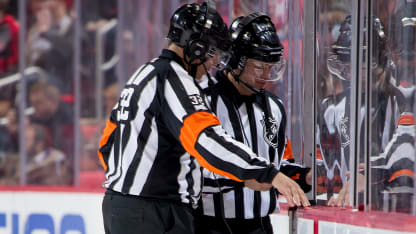"They've upped the ante," New Jersey Devils coach John Hynes said. "Although they've added some challenges, they've made the stakes higher, basically saying they don't want challenges."
The goalie interference challenge will still likely cause coaches the biggest headache because it's the most subjective of the calls eligible to be challenged and now the NHL has attached the risk of a penalty if wrong.
"There are going to be some hiccups, I'm sure," Carolina Hurricanes coach Rod Brind'Amour said, "but we're moving towards getting the calls right, which is what everybody wants."
The League augmented the rule on helmets for player safety purposes.
A player whose helmet comes off during play will be assessed a minor penalty if he doesn't either go to the bench or go retrieve his helmet and put it back on properly within a reasonable time period, which will be determined by the officials.
"They're doing their best to keep us safe as much as they can but at the same time not affecting the game," Lowry said. "I like that they left that kind of judgment up to the refs."
There were a series of adjustments in the rules to create more offense.
The face-off will stay in the offensive zone even if the attacking team is responsible for the puck going out of play. Previously, face-offs remained in the offensive zone only when the puck went out of play after being shot at the net.
Defensive teams can't make line changes if their goalie freezes the puck on a shot from outside the red line or if one of their skaters causes a stoppage by unintentionally dislodging the net. The officials will not grant a timeout or go to a television break in such instances.
The attacking team will be able to select which circle they want the face-off to take place on plays following an icing, the goalie freezing the puck on a shot from outside the red line, a defensive skater unintentionally dislodging the net and to begin a power play.
NHL.com staff writers Tim Campbell and Tom Gulitti contributed to this report

